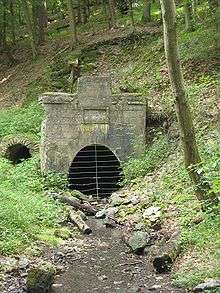Pit water
Pit water, mine water or mining water is water that collects in a mine and which has to be brought to the surface by water management methods in order to enable the mine to continue working.
Origin
Although all water that enters pit workings originates from atmospheric precipitation, the miner distinguishes between surface water and groundwater. Surface water enters the pit through openings in the mine at the surface of the ground, such as tunnel portals or shaft entrances. During heavy rain, water seeps into the earth and forms ground water when it meets layers of impervious rock. Pit water is mainly interstitial water and groundwater that seeps into the mine workings.[1]
See also
Literature
- Friedrich P. Springer (2007), "Von Agricolas „pompen“ im Bergbau, „die das wasser durch den windt gezogen“, zu den Gestängetiefpumpen im Erdöl" (in German), Erdöl/Erdgas/Kohle Zeitschrift Heft 10
- Ch. Wolkersdorfer (2008) (in English), Water Management at Abandoned Flooded Underground Mines – Fundamentals, Tracer Tests, Modelling, Water Treatment, Berlin: Springer, pp. 466, ISBN 978-3-540-77330-6
- P. L. Younger; S. A. Banwart; R. S. Hedin (2002) (in English), Mine Water – Hydrology, Pollution, Remediation, Dordrecht: Kluwer, pp. 464, ISBN 1-4020-0137-1
- P. L. Younger; N. S. Robins (2002) (in English), Mine Water Hydrogeology and Geochemistry, London: Spec. Publ. – Geol. Soc. London, pp. 396, ISBN 978-1-86239-113-0
References
- ↑ Carl Hartmann: Handwörterbuch der Berg-, Hütten- u. Salzwerkskunde der Mineralogie und Geognosie. Third volume, 2nd edition, Buchhandlung Bernhard Friedrich Voigt, Weimar, 1860
External links
| Wikimedia Commons has media related to Pit water. |
- Gut aufgehoben? – article about the possibility of restoring acidic pit water using CO2-storage at planeterde
This article is issued from
Wikipedia.
The text is licensed under Creative Commons - Attribution - Sharealike.
Additional terms may apply for the media files.
